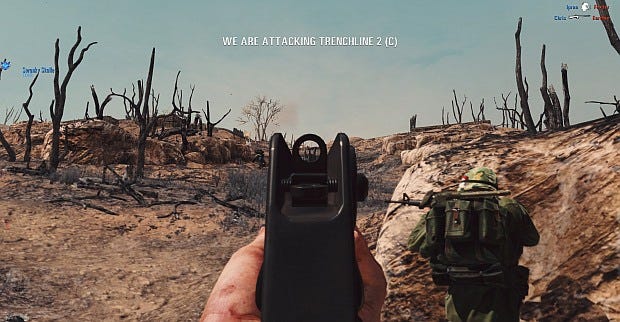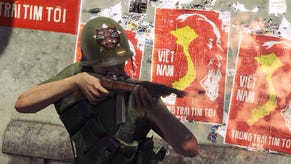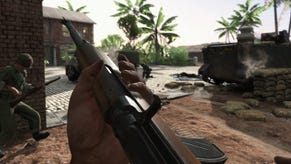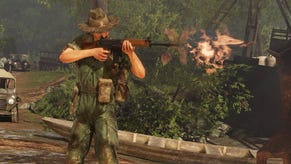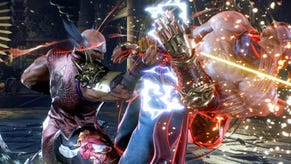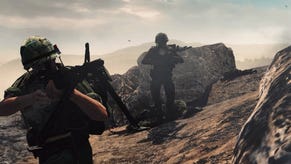Wot I Think - Rising Storm 2: Vietnam
Tense, tactical, and rough
As soon as I peek out over the wall, bullets zip past my head and ricochet off the bricks around me. I duck back down, my screen blurring. I'm pinned down. That is, until the artillery comes down on the enemy trench, its screeches echoed by the cries of the Americans caught in the blasts. I pop my head back up to have a look at the light show and my screen turns black. A second later the kill feed updates. I was shot in the head, apparently.
This ends up happening a lot in Rising Storm 2: Vietnam [official site]. The original Rising Storm, a spinoff from Tripwire’s Red Orchestra 2: Heroes of Stalingrad, was an unforgiving shooter and this is no different. Being a beginner in this game is a struggle. You’ll die in one shot, often from an unseen enemy. You’ll kill teammates by accident and get shouted at in chat. But if you’re willing to get over the initial bumps and you’re happy to play it the way it’s supposed to be played, then the payoff is more than worth it.
Matches consist of up to 64 players, and in each of the three game modes involve American and Vietnamese soldiers capturing and holding objective points on large, varied maps. The combat has a wonderful rhythm to it. You push up to cover and hunker down, forming a standoff with the enemy. Then, one man will make a break for it, perhaps under the cover of smoke, and move up to the next cover line while teammates provide suppressing fire from behind. Most of the combat takes place at medium-to-long range until you reach a control point, and then it’s a game of hide and seek as enemies lurk just around the corner, ready to pounce if you dare take more ground.
The mechanics all tie together to create a uniformly tense experience, encouraging a slow pace that makes the bursts of action feel more meaningful. If you’re next to cover, for example, your aim will automatically stabilise, providing you with a clear shot. If enemy bullets whizz too close to your cover spot, you'll become suppressed, and your soldier's nerves will disrupt their aim. No matter how calm you are, there’s no aiming reticle and the 30 or so guns all have a lot of recoil, meaning aiming down the sights and burst-firing is a must.
Success is often not about how well you can aim, but about positioning and teamwork. If you get a good angle on an enemy squad you can rack up kills without having to do too much. Flanking is often the best way to overcome the enemy, and because your shots won’t show up on the map you can often find a good spot and keep picking off enemies one by one, which feels excellent.
Even on public servers, I got a real kick out of working as a team, either with squad mates – a team of six that grants some passive bonuses when near to each other – or just with allies who happened to be around me at the time. Without any real communication players will band together and rely on each other to survive. Most of those players will be playing as basic grunts, but there’s a limited number of slots for a variety of classes designed to specialise in a particular role. On the American side, for example, I gravitated towards the Pointman, who takes the lead in fights and uses smokes to provide cover for your team's advances. Even when I wasn’t getting kills I felt like I was contributing and when it all comes together you feel like part of a well-oiled machine.
Although there’s no tangible progression system (unlocks only gives you cosmetic items, thankfully, which keeps the playing field level), the game does have a learning curve that keeps you pushing on to try new things. Once you’ve mastered the basic roles, you can try being a squad leader and create forward spawn points for your squad mates. Then you can move on to an advanced class like the Sapper, who specialises in setting up land mines and traps. Then – and only when you really know the game – you can try your hand at being a commander.
The commander role is really what defines Rising Storm 2. The commander has a number of abilities that turn the tide of a fight, from calling down napalm to sending up a spy plane that marks all enemies on the map. They fuel Rising Storm 2’s best moments. Getting caught in an enemy artillery strike is genuinely terrifying, and often all you can do is lie hopelessly behind some flimsy cover hoping for the best as the shells rain around you. I shied away from the role on the whole, and when I did try it out I felt a lot of pressure to get it right. Thankfully most commanders know what they are doing and I can probably count on one hand the number of games where a sloppy commander has been the reason for a defeat.
For all the praise I’ve heaped on this game so far, it does have some rough edges. The movement system is a constant source of frustration and I’ve got stuck in the environment on countless occasions. The game can’t decide whether to let you go prone in some spots and you end up in a jerky crouch that you can’t get out of. Vaulting over cover feels imprecise: sometimes the game just won’t let you do it until you’re pointing at a very specific, seemingly arbitrary spot on the wall or fence you’re trying to hop over.
There are a few other niggles: servers failed to load altogether for me occasionally; you can crawl through some solid objects, including your teammates’ bodies; and the Vietnamese voice acting is just painful to listen to. Oh, and the helicopters promised to be a big part of the game? They’re only available in a couple of maps and even there they’re often more trouble than they’re worth because they can be taken out by a single RPG.
There’s also questions about the game’s longevity. At the moment there’s eight maps, and no real weaknesses in the lineup. In other games that would be enough but it doesn’t feel that way here. Because Rising Storm 2 is so reliant on positioning, fights often gravitate towards the same choke points or the same reliable cover spots. You can’t freely roam around because doing so is a good way of getting yourself killed. Therefore the maps feel smaller than they actually are and matches on the same maps often feel very similar. For the first 15 hours or so that’s fine but past that you might find yourself yearning for the variety. That’s especially true in Supremacy mode (where teams battle for a set number of control points over a large area), which only has two maps.
The cynic in me worries that a large portion of the potential player base will either find the game too hard at the beginning – a phenomenon that will only worsen with time as other players gain experience – or sink 20 hours into the game and simply grow bored. More maps are incoming, Tripwire says, and whether the game's servers remain busy will depend on how well they’re received.
But those issues did not come close to ruining Rising Storm 2 for me. It’s not the most polished shooter but it does shine in all the right places, and it builds on the huge potential of Red Orchestra, which I loved. There are very few games that can match the feeling you get when you watch an artillery strike destroy a treeline and push up with your squad mates under the cover of smoke and deafening explosions. If you’re after a slower-paced shooter with tactical combat and tense moments, then it’s time to enlist.
Rising Storm 2: Vietnam is out now on Windows via Steam and Humble for £19/$25/€23.
